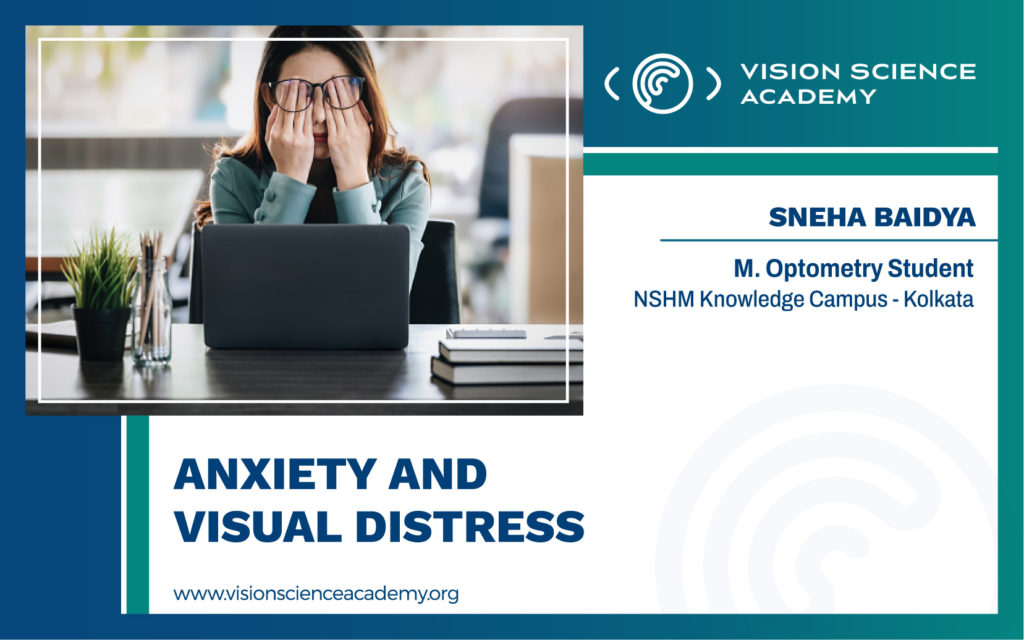Sneha Baidya, B. Optom
Optometry Student, NSHM Knowledge Campus – Kolkata, India
According to American Psychological Association, anxiety can be defined as an emotion characterised by feelings of tension, worried thoughts, and physical changes like sweating, trembling, dizziness, or a rapid heartbeat. (1)
An anxiety disorder makes the person feel anxious most of the time, without any apparent reason. In some cases, the anxious feelings may be so uncomfortable that the person may stop routine activities.
Did you know?
Anxiety Disorders are the most prevalent psychiatric morbidities and are the sixth leading cause of disability worldwide with 4% of all YLD (years of healthy life lost due to disability). (2)
A recent study in India stated that after COVID 19, 74% of Indians suffered from stress while 88% suffered some kind of anxiety disorder. (3)
Figure 1: Pictorial description showing signs of anxiety
Anxiety And Our Eyes
Another major effect of anxiety is Visual Distress. Anxiety not only increases heart rate but also greatly creates visual disturbances, it has short term as well as long term effects.
How anxiety causes visual distress?
As a consequence, the following thing is to be considered.
- The human body counteracts anxiety by activating the parasympathetic nervous system, causing ciliary muscle contraction, and is mediated by a complex network of the parasympathetic nervous system (PNS) via the Edinger-Westphal nucleus.
- Dilating pupils to take in more visual information,
- Narrowing field of vision (peripheral vision) to focus solely on the threat,
- Reduce blink rate so we do not miss important visual information, and
- Increase blood flow to the eye muscles so that they are more reactive.
Anxiety and its effects
Figure 2: Anxiety and ocular strain
- Blurred vision- one may feel sudden blurring of vision or strain in viewing mostly near objects.
- Floaters- small dots, squiggly lines, small insects floating in front mostly under bright light conditions.
- Eye flashes- sudden flashes of light may be felt coming from the corner of your eyes
- Eye twitch- a twitch in the eye muscles that will not go away too soon
- Watery eyes- one may feel constant need to wipe their eyes
- Dry eyes- one may feel burning sensation in their eyes
- Light sensitivity- one may feel difficult to adjust in bright light
- Pseudo myopia and anxiety: Pseudo myopia is an inappropriately excessive accommodation of the eye due to overstimulation of ciliary spasm, which leads to a marked approximation of the far point. Generalised anxiety disorder is the most common psychiatric illness associated with Pseudo myopia with a positive correlation between anxiety-somatization scores and accommodation amount of the eye. (4)
- The combination of digital eye strain, anxiety and stress is a scary mix.
Anxiety and glaucoma: According to research published in the EPMA Journal, ongoing psychological stress with elevated levels of cortisol disrupt blood flow to the eye and brain becoming risk factors in the development and progression of deteriorating vision. Another study published in the academic journal Applied Ergonomics draws a link between stress and glaucoma. It shows that prolonged stress coupled with increased intraocular pressure together can be a contributing factor in causing glaucoma. (5)
Treating anxiety related visual distress (An Optometrist’s perspective)
- Detailed history helps in the differential diagnosis. Proper history of the patients regarding their occupation, their working and lifestyle habits, their medications should be noted.
- Establish a diagnosis using dynamic Retinoscopy during episodes of accommodative spasm.
- Psychiatric consultations and work environment changes, ocular exercises, and using cycloplegics (4) to relax the ciliary muscle spasm.
References
- American Psychological Association. (n.d.). Anxiety. Retrieved from Psychology Topics: https://www.apa.org/topics/anxiety, [Last Accessed: 23Apr20238:00pmAEST]
- National Health Portal. (n.d.). Anxiety Disorders. Retrieved from nhp.gov.in: https://www.nhp.gov.in/Anxiety-Disorders_mtl [Last Accessed: 23Apr2023;8:05pmAEST]
- statista. (2023, Mar 8). State of Health. Retrieved from Health, Pharma & Medtech: https://www.statista.com/topics/6944/mental-health-in-india/#topicOverview
- Khalid K, Padda J, Pokhriyal S, Hitawala G, Khan MS, Upadhyay P, Cooper AC, Jean-Charles G. Pseudomyopia and its association with anxiety. Cureus. 2021 Aug 24;13(8).
- Varma, D. R. (2019, Jan 17). How Glaucoma, Anxiety and Depression Are Connected. Retrieved from Dr. Rohit Varma: https://drrohitvarma.com/how-glaucoma-anxiety-and-depression-are-connected/ [Last accessed: 23Apr23;08:10pmAEST]
